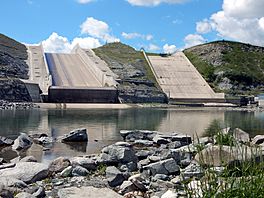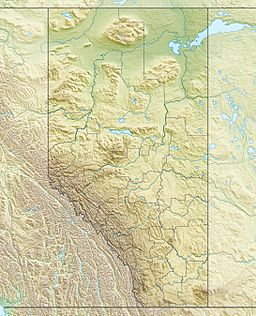St. Mary Reservoir facts for kids
Quick facts for kids St. Mary Reservoir |
|
|---|---|

The disused (right) and replacement (left) spillways of St. Mary Reservoir
|
|
| Location | Cardston County, Alberta |
| Coordinates | 49°19′15″N 113°12′42″W / 49.32083°N 113.21167°W |
| Basin countries | |
| Max. length | 7.9 km (4.9 mi) |
| Max. width | 9.9 km (6.2 mi) |
| Surface area | 37.5 km2 (14.5 sq mi) |
| Average depth | 10.4 m (34 ft) |
| Max. depth | 56.4 m (185 ft) |
| Surface elevation | 1,100 m (3,600 ft) |
The St. Mary Reservoir is a large, human-made lake in southwestern Alberta, Canada. It was created by building a dam across the St. Mary River. This project was finished in 1951. The main reason for building the reservoir was to store water for irrigation, which means watering crops.
The Kainai Nation's Blood 148 Indian reserve is located next to the northwest side of the reservoir. St. Mary Reservoir is a popular spot for many outdoor activities. People enjoy camping and having picnics there. It's also a great place for power boating, water skiing, windsurfing, swimming, and fishing.
Contents
Discovering Wally's Beach Site
A very important place called the Wally's Beach site (DhPg-8) was found at the reservoir. This site is special because it holds clues about ancient animals and early humans from a long, long time ago. It was discovered in 1998 when the reservoir was partly drained to build a new spillway. A spillway is like a giant overflow drain for a dam.
When the water level dropped, the plants that had been growing underwater died. Then, the wind started to blow away layers of unprotected sand and silt. This process, called `wind erosion`, uncovered amazing things. Scientists found `trackway`s (footprints) and bones of animals that are now extinct. They also found `stone tool`s that were used by ancient hunters, known as `Paleo-Indians`.
After a few years, the reservoir was refilled, and the Wally's Beach site went back underwater. The bones and tools found at the site are now kept safely at the Royal Alberta Museum.
How Old Is the Wally's Beach Site?
Scientists use a method called `radiocarbon dating` to figure out how old ancient things are. This method looks at the amount of carbon in old bones and other remains.
Dating Ancient Animal Bones
Based on early tests of animal bones from St. Mary Reservoir, the site was thought to be about 11,000 years old. This means it was from the very end of the `Pleistocene` Ice Age and the beginning of the `Holocene` period. However, in 2015, scientists re-examined the bones of camels, horses, and muskoxen. New dating showed that these bones are actually much older, between 13,100 and 13,300 years old.
What Was the Environment Like Long Ago?
About 11,000 to 13,000 years ago, the area around St. Mary Reservoir looked very different. The huge `Laurentide Ice Sheet`, a giant glacier from the last Ice Age, had recently melted away from this region.
A Windswept Grassland Home
The site was a `semi-arid plain`, meaning it was quite dry and open. Strong winds blew across the land. It was covered with grasses and small shrubs, much like the vast `mammoth steppes` that existed in Europe and Asia during the Ice Age. This rich, open grassland, along with the reliable water from the river, was perfect for large herds of animals. Many big mammals from the late Pleistocene period lived and thrived here.
What Ancient Animals Lived Here?
The Wally's Beach site is a treasure trove of `fossils`. Scientists have found many different types of animal remains.
Skeletal Remains and Footprints
The fossil collection includes bones of several extinct animals:
- The extinct `musk ox` called Bootherium bombifrons.
- The extinct `bison` called Bison antiquus.
- The `caribou` (Rangifer tarandus), which still live today.
- Wild horses (Equus ferus).
- The `American badger` (Taxidea taxus), also still alive today.
- Other animals like `mustelids` (weasel family), `canids` (dog family), and `ground squirrel`s.
Besides bones, scientists found amazing `footprints` and `trackway`s preserved in the silt. These include tracks from:
- The extinct `woolly mammoth` (Mammuthus primigenius).
- The extinct `camel` (Camelops hesternus).
- More footprints from horses, bison, and caribou.
Some of these trackways show how the animals behaved. For example, they show evidence of animals eating plants, moving in herds, and interacting with each other.
Mammoth Herd Health
In a study from 2005, scientists measured the footprints of mammoths. They found that only about 30% of the mammoths were young animals. In healthy herds of modern African elephants, about 50% to 70% are young. Lower numbers of young animals can mean the herd is under stress, sometimes from hunting.
The original dating for these mammoth footprints was 11,000 to 11,300 years ago. Both the original and the re-examined dates for the site place these footprints at a time when humans were spreading across North America. This suggests that the presence of humans might have been connected to a decline in the health of these mammoth herds.
What Tools Did Early Humans Use?
The large herds of animals and the steady water supply at St. Mary River attracted early human hunters. The tools and other items found at the site suggest it was a place where these `Paleoindian` hunters often came to hunt.
Ancient Hunting Tools
Most of the items found are small pieces of stone, called `flakes` or `flake fragments`. These are left over from making tools. Scientists also found:
- A `stone chopper`, which is a tool used for chopping.
- A piece of a `biface`, which is a stone tool shaped on both sides.
- A few `flake tool`s, which are sharp tools made from stone flakes.
These tools were found near the remains of horses and muskoxen. This suggests they were used for hunting or processing these animals. Even more exciting, scientists found `Clovis point`s (a type of spear point) that still had traces of horse and bison protein on them. This is direct evidence that these early humans hunted these animals.


